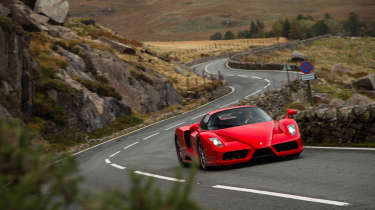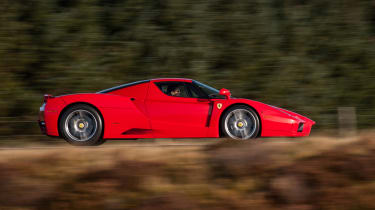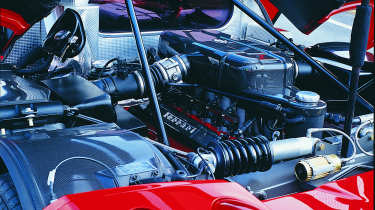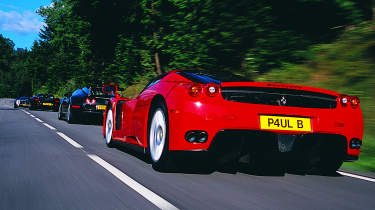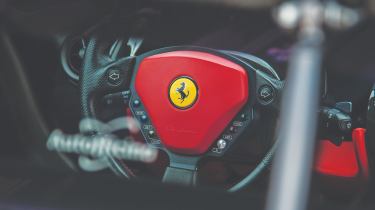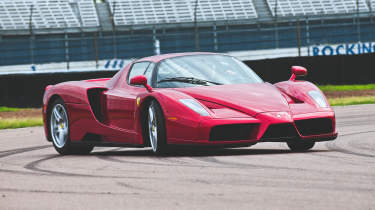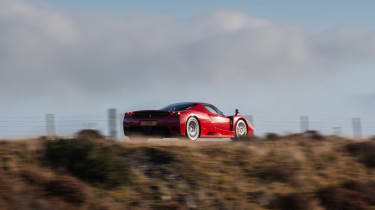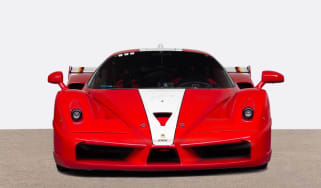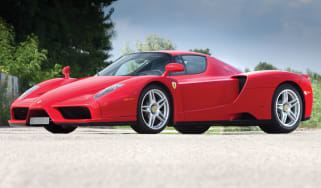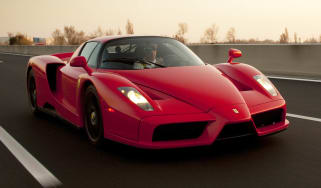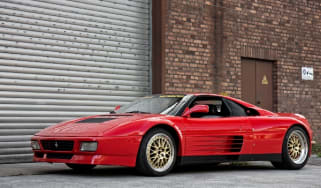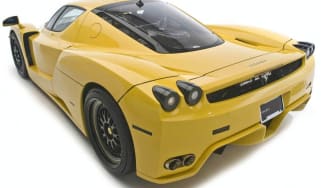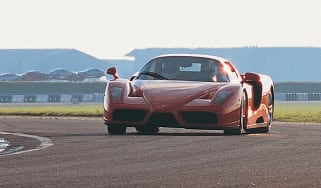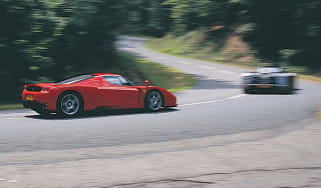Ferrari Enzo (2002 - 2004) – review, history and specs of an iconic hypercar
Ferrari's final mid-engined, naturally aspirated flagship hypercar, the Ferrari Enzo is a towering icon of the brand’s modern history
Ferrari’s own description of the Enzo was ‘the closest you can get to the F1 experience in a road car’, generously referring to the noise of the engine, the paddle-shift gearbox and the feel of the chassis than outright performance. It certainly used F1 technology and at the time, was as close as mere mortals would get to driving an F1 car, even if its naturally aspirated, 650bhp 8500rpm V12 redlined some 10,000rpm shy of the V10 F1 machinery of the day.
In the middle year of Schumacher’s five consecutive F1 world titles Ferrari launched the Enzo in celebration of its F1 achievements and to honour the company’s founder Enzo Ferrari. It drew heavily on the company’s motorsport know how and placed its glorious V12 amidships in a carbonfibre tub. It was a bold move for Ferrari to name a car after its founder, but the Enzo was a bold car, follow-up to the Ferrari F50 and more technologically advanced than any Ferrari short of the firm’s Grand Prix cars at its launch in 2002.
At that time of maturing engine technologies, the Ferrari Enzo perhaps best represented the breed of naturally aspirated, mechanical hypercars built before there era of turbocharging, hybridisation and electronic intervention fully took hold. With 650bhp, a claimed 3.1s 0-62mph time and a 217mph top speed, the Enzo had figures that spoke for themselves and are still impressive today.
More reviews
It also ticked all the other boxes you’d expect of a limited-run model (Ferrari made just 400 units) from one of the world’s most desirable brands, from its spectacular styling to a heart-stopping £450,000 price – though anyone who got in on the ground floor has made a mint considering what Enzos now change hands for.
If they’ve not driving their cars though, they’re missing out. While the Enzo is not evo’s favourite Ferrari, that’s only because others – 288 GTO, F40, F50 and LaFerrari – have been quite so spectacular in their own rights. How the F80 stacks up remains to be seen...
Ferrari's supercar history
The term hypercar is one only coined in recent history, but in truth Ferrari has been making them since before the word was invented, not as an exercise of pride, but to fund Enzo Ferrari’s passion for racing. As such, the linage preceding the Enzo is a distinguished one. The first of the Enzo’s direct forbears arrived in 1984, when Ferrari introduced itself to turbocharging with the 288 GTO.
Like the first Ferraris, the 288 GTO was designed specifically as a homologation special, in this case allowing Ferrari to compete in an upcoming Group B race series. This model took the bones of a series-production Ferrari 308 GTB, but replaced its transversely mounted 3-litre V8 for a twin turbocharged 2.9-litre V8 positioned longitudinally. Carbonfibre and Kevlar bodywork featured for the first time on a Ferrari, essentially creating the company’s first hypercar.
The 288 GTO was genesis, but it also formed the base of one of Ferrari’s most iconic models, the F40. Launched just four years after the 288 GTO, the F40 was not designed for the racetrack, instead it was made to thrill on the road. Named to celebrate Ferrari’s 40th birthday, it was also the company’s first road car to be based around a carbonfibre chassis, with subframes carrying the drivetrain and suspension components.
Heralded for its exquisite driving characteristics and intense twin-turbo V8, the F40 was a tricky model for Ferrari to supersede, and the car they did it with felt the heat right from its introduction. In 1995 the F50 dropped the turbocharged V8 engine in favour of a highly strung V12, itself a development of Ferrari’s contemporary Formula 1 engine. The F50 was criticised in some quarters for its harsh engine and tricky driving dynamics, but it again represented distinct progress for this Ferrari model line.
Ferrari Enzo in detail
The Enzo, launched in 2002, took lessons learnt from each of the aforementioned iconic models to form the basis of what was by now called a hypercar. The Pininfarina-styled body might not be the most classically pretty design to come out of Modena, but the Enzo’s sharp detailing and Formula 1-derived aerodynamics informed the design to an extent unseen in previous Ferraris.
Without the large rear spoilers of its predecessors, the Enzo instead used clever aerodynamic tools to produce downforce and eliminate lift. The low, angular front helped pin the nose of the car down in faster corners, while the rear diffuser and flat floor negated the need for a large rear spoiler. At speed, a smaller rear spoiler would still rise to assist the rear aerodynamics.
Limited to a production run of just 400 units – the final build model was gifted to the Pope – the Enzo eventually went on to form the basis of the track-only FXX. Maserati created its own derivative using the same component set, calling it the MC12. The MC12 was limited to 25 units, although its main purpose was to homologate the MC12 race car for the FIA GT Championship.
Ferrari Enzo engine – F140 V12 that still powers the 12 Cilindri
The Ferrari driving experience has always had one dominating factor: the powertrain. The Enzo is the last naturally aspirated, non-electrically-assisted hypercar from the Italian manufacturer, and the V12 used was more than enough to satisfy the moniker.
The F140 engine was introduced in the Enzo, at the time setting the record as the most powerful naturally aspirated engine in the world. With four valves per cylinder, dual overhead cams and variable valve timing, the Enzo produced a maximum power output of 650bhp and 485lb ft of torque.
This engine is undoubtedly core to the Enzo’s legacy today. Almost every V12 Ferrari that’s come since, for instance, used derivations of the F140 V12. The 599 even had the Enzo’s distinctive guttural vocal signature. It went on to serve in everything from the LaFerrari, to the GTC4 Lusso. The engine lives on still, even in 2025, in the Ferrari Purosangue and 12 Cilindri, some 17 years on from the Enzo’s debut.
The performance figures for the Enzo were rightly impressive, with the Enzo shooting to 62mph in 3.1 seconds and on to a 217mph top speed. Harnessing this power is a six-speed automated manual transmission, a development of prior systems. Ferrari was able to upgrade the hardware and software compared with previous iterations to give the Enzo lightning fast shifts up and down, setting the template for its world-leading semi-automatic gearboxes.
Ferrari Enzo technical details
Again based on the developments made in prior Ferrari hypercars, the Enzo’s independent double-wishbone suspension featured pushrod-actuated dampers that were adjustable by the driver. Braking was handled by Ferrari’s latest carbon-ceramic brakes, offering enormous stopping power without the threat of significant fade.
The Enzo offered a super-quick steering ratio, something that could only be supported by the immense front-end grip available, and although it is not the most feelsome steering set-up, it does offer extreme accuracy and is confidence inspiring.
Like its predecessors, the Enzo was designed to push the performance boundaries of what was possible in a road car. The interior treatment could be called ‘pared back’ as a result, with many surfaces in carbonfibre, and creature comforts such as electric windows and a stereo all sacrificed in the quest for a low kerb weight.
One place the Enzo didn’t skimp was in its new-age electronic traction control systems, with the Enzo offering multiple different driving modes on its motorsport-inspired steering wheel. It also introduced an element now common within the current Ferrari line-up: steering wheel mounted shift lights.
Ferrari Enzo – rivals and successors
The notion of this era being the height of naturally aspirated engines was not one just inhabited by Ferrari. In 2002, rival manufacturers were also on the cusp of launching momentous cars of their own. From Mercedes-McLaren and Porsche came hypercars with corresponding performance capabilities to give the Enzo some proper competition.
Mercedes-Benz and McLaren had decided to progress their technical partnership in Formula 1 to create the contrived SLR McLaren. The carbon-bodied 617bhp hypercar utilised a version of Mercedes’ 5.4-litre supercharged V8 engine and a five-speed automatic gearbox. Although incredibly quick in a straight line, the SLR’s GT aspirations meant it was not as sharp to drive as the Enzo.
> New Ferrari F80 hypercar: £3.1m LaFerrari successor with 1184bhp V6 hybrid
The Porsche Carrera GT was a bigger threat, itself utilising a spectacular naturally aspirated 5.7-litre V10 engine based on an abandoned World Endurance Car project. The Carrera GT matched the carbon-ceramic brakes, carbon tub construction and pushrod suspension of the Enzo. Although it had 'only' 603bhp, it more than made up for that by offering no shortage of driving thrills.
The Enzo was succeeded by the LaFerrari in 2012, which also used a carbon tub and a version of the F140 V12. It added hybrid power and featured a dual-clutch gearbox in place of the single-clutch seen in the Enzo. Today’s F80 is grandson of Enzo, which before its reveal was dubbed by some the F60. With a V6 engine and four-wheel-drive, the F80 ought to be worlds apart in character to the Enzo, but even with its twin turbochargers, can rev 1000rpm higher.
Ferrari Enzo values
Given the Enzo cost around £450,000 at launch, owners and investors have done rather well out of the car and prices are still rising. In late May 2020 an online auction record was set at RM Sotheby’s, achieving $2,640,000 – around £2 million. Fast forward to the middle of 2024 and several examples changed hands at auction for just under $4,500,000, circa £3.5 million. If you’d wanted Fernando Alonso’s Enzo you’d have needed €5,400,000 (c4.5 million today) to buy it back in 2023
It's a crying shame when you see how many miles some of these machines have covered – you’ll be lucky to find many for sale that have covered as many as 10k miles, many with far fewer. If you have had the temerity to drive your Enzo that does have an effect on its value with a 27k mile example making ‘only’ $2.6 million (c£2 million) in a USA sale in 2024.
To get the best price an Enzo needs to have good provenance, comprehensive service history – even if it’s a low mileage example – and to be in pristine condition. What colour the example is will have a big bearing on relative values too.
What we said
‘Trickle out of the pits, engage second, squeeze the throttle with its perfect ball-jointed linkage and – BLAM! Not pause-whoosh-blam like a turbocharged F40; this is instant, howling, Pavarotti-meets-Robert-Plant blam, like an F50 except that the g-force is even more compressing. This is the most violent munching of tarmacadam I have ever experienced outside a race car. It is scarcely credible. A couple more gears, then that right-hander.
‘A racing car’s carbonfibre brakes don’t work very well from cold, but these are designed to be real-world usable at, apparently, a small cost in outright bite. What cost this can be I can’t imagine, because no road car I’ve driven before has brakes like these. You can even feel (and hear) the abrasion going on, like coarse sandpaper cutting through old paint, yet the discs are claimed to last for the entire life of the car. There’s ABS and electronic brake-force distribution, by the way, neither of which are very Formula 1, for all the Enzo’s aura of a racing-car-for-the-road. Not to worry. These systems don’t get in the way at all. They just increase your trust.
‘Now, courage. Full throttle past the pits, tighten jaw, trust those brakes. Good. Turn, feel the front bite into the corner, sense friction’s ever-modulating coefficient through the steering, squeeze on some power as the bend opens out. The steering doesn’t seem so slow now that the tail is nudging into gentle oversteer and the agility is unlocked. Through the temporary chicane, right over the bridge, feel the nose wash a little wide, lift, accelerate again on the right rubber-streaked line. Down to the hairpin, power round, sense the ASR intervening for the first time as systems take over to quell first understeer, then a tail-flick.
‘This is more suggestion than compulsion; the calibration is perfect, the feel totally friendly as you wonder if you’ll ever dare reach the maximum 1.36 cornering g. Two laps on, I’m in Ferrari heaven. The Enzo does exactly what you want it to do, when you want it to, either channelling its mass in the most useful direction or shrugging it off altogether. I never thought a 575M Maranello could feel cumbersome, but I remember how it tackled Fiorano’s curves – rather well, I thought at the time – and using the circuit as a calibration standard I’m afraid the 575M has just found itself recalibrated.
‘The Enzo’s engine is glorious, the pace is as ferocious as 650bhp promises to make it: 0-62mph in 3.65 seconds, 0-124 in a dimension-shifting 9.5 where the Enzo’s ancestors trailed in double-figure territory, and a top speed nudging 220mph. And there’s something Silicon Valley-precise about the throttle response, an empathy with the technology that repaired the Hubble space telescope by such microfine remote control. I suppose it’s the way it delivers the response you want, opening the way to a transparent, digitally-enhanced world instead of fumbling around and missing the point because it thinks it knows best. The Enzo’s electronic brain has insight.’ – Ferrari Enzo first drive, John Simister (evo 47, September 2002)
‘As the Enzo winds through the intermediate gears, revs flaring and tail shimmying as the meat of the torque arrives at 4500rpm, there’s the sense that even a grand and sprawling stage can be found wanting by the demands and performance envelope of our 217mph projectile. The Enzo is a big, broad car that fills its side of the road and more. You become familiar with the kerdug-kerdug-kerdug of the right-hand tyres slapping across the catseyes, and when you encounter oncoming traffic you instinctively breathe in as a ton-and-a-half of steel flashes by its precious composite flank.
‘The steering has that unmistakable urgency and pointiness that defines all turn-of-the-century Ferraris. It’s alert and aggressive, enough to require calm hands and measured inputs if you’re to avoid over-agitating the Enzo as you turn in, but the upside is a front end that you know will always change direction and never wash wide of its mark. Coupled to the razor-sharp throttle response and a rampant V12, you really need to dance the Enzo through fast corners with small, precise inputs.’ – Enzo v LaFerrari, Blood Brothers, Richard Meaden (evo 203, 2014)
Ferrari Enzo specs
| Engine | V12, 5998cc |
| Max power | 650bhp @ 7800rpm |
| Max torque | 485lb ft @ 5500rpm |
| Transmission | Six-speed semi-automatic, rear-wheel drive |
| Tyres | 245/35 ZR19 front, 345/35 ZR19 rear |
| Weight (kerb) | 1480kg |
| Power/weight | 439bhp/ton |
| 0-62mph | 3.1sec (claimed) |
| Top speed | 217mph (claimed) |
| Price | £450,000 (2002) |
